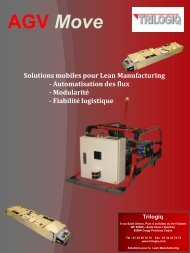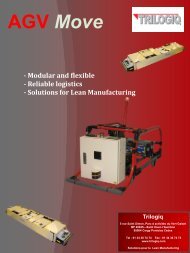Create successful ePaper yourself
Turn your PDF publications into a flip-book with our unique Google optimized e-Paper software.
History<br />
16<br />
At the end of 1890, Frederick W Taylor<br />
became the first to study work management<br />
scientifically and distribute the results.<br />
His work led to the formalization of time<br />
and motion studies and the setting of<br />
common standards.<br />
Frank Gilbreth then added the concept of<br />
breaking work down into elementary time<br />
blocks.<br />
It was around this time that the first notions<br />
of eliminating waste and studying movement<br />
began to emerge.<br />
In 1910, Henry Ford invented the assembly<br />
line for his standardized Ford Model T.<br />
Alfred P. Sloan improved on Ford’s system<br />
when he introduced the concept of assembly<br />
line diversity at GM.<br />
After the Second World War, Taiichi Ohno<br />
and Shingeo Shingo created the “Just In<br />
Time”, “Waste Reduction” and “Pull System”<br />
concepts for Toyota, which, together with<br />
other flow management techniques, resulted<br />
in the Toyota Production System (TPS).<br />
The TPS has been evolved and improved ever<br />
since.<br />
In 1990, James Womack summarized these<br />
concepts to create Lean Manufacturing at a<br />
time when Japanese expertise was spreading<br />
to the West and the success achieved by<br />
companies applying these principles and<br />
techniques became undeniable.<br />
The Lean Manufacturing house can only grow<br />
if its foundations are built first.<br />
Without using a highly flexible and modular<br />
system that allows muda to be eliminated and<br />
Kaizen attitudes to be introduced into the<br />
plant, it is impossible to proceed to the later<br />
Standardize<br />
work<br />
The 7 mudas<br />
Lean Manufacturing identifies<br />
7 areas of waste or «muda».<br />
steps of Lean Manufacturing, which are work<br />
standardization, sequencing (Heijunka) JIT and<br />
JIDOKA. The systematic use of LeanTek ® acts<br />
as a catalyst for the policy of waste reduction<br />
and as a tool for implementing the Kaizen<br />
attitudes of continuous improvement.<br />
Muda caused<br />
by unnecessary<br />
stock<br />
Muda caused by<br />
overproduction<br />
KAIZEN<br />
Muda caused by<br />
defects/rejects<br />
Muda caused<br />
by unnecessary<br />
movement<br />
Muda caused<br />
Muda caused by<br />
by transport<br />
inappropriate<br />
processing<br />
Muda caused<br />
by waiting<br />
Progress<br />
17













